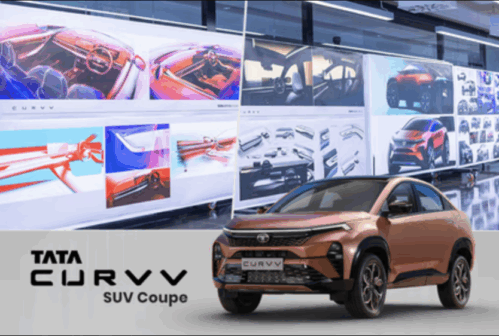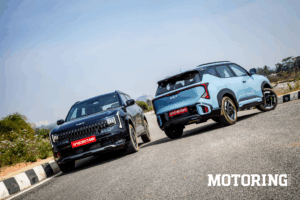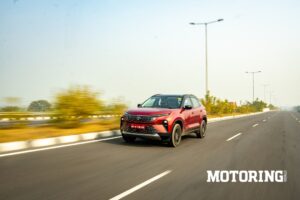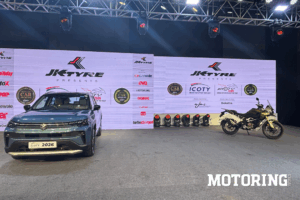In an interview with Motoring World, Mr. Ajay Jain, Head of India Design Studio at Tata Motors, pulls back the curtain on the philosophy shaping the next generation of Indian electric vehicles. He reveals how his team masterfully balances global design standards with a deep understanding of Indian culture, driving habits, and aspirations to create EVs that are not just technologically advanced but also intuitive, sustainable, and deeply resonant. From overcoming design constraints to integrating visible and invisible tech, Jain offers a comprehensive look into the purposeful design language defining Tata’s electric revolution.
Motoring World: How do you balance aesthetics, ergonomics and tech to create intuitive EVs for first-time buyers?
Ajay Jain: Creating intuitive electric vehicles (EVs) for first-time buyers requires a deliberate balance of aesthetics, ergonomics, and technology, with a strong focus on building user confidence. At Tata Motors, we ensure that every EV is visually compelling – communicating trust and innovation through a bold yet refined design language. This purposeful aesthetic, with its clean surfaces, distinctive lighting signatures, and proportions that convey strength and modernity, makes the vehicle feel both aspirational and approachable, giving first-time buyers a sense of confidence and desirability. The interior design follows an inside-out philosophy, prioritizing space, comfort, and usability. Our EVs feature spacious cabins with optimized seating layouts, tailored material choices that feel warm and bright, and intuitive controls with minimal clutter. This design language creates a welcoming and easy-to-navigate environment, ensuring that first-time EV users feel at ease.
Technology is integrated in a way that simplifies, rather than overwhelms the user. For new buyers, this means having simplified digital interfaces that provide clear, responsive feedback and smart connectivity features that are easy to access and personalize. Crucially, range and charging information are presented in reassuring, user-friendly formats. The ultimate goal is to reduce anxiety around EV adoption – whether concerning range, charging complexity, or unfamiliar controls – by making technology feel assistive, not intrusive. This holistic approach extends to emotional design, where vehicles are crafted to evoke trust and reassurance. Through consistent brand cues and quality finishes, and a design that balances energizing sophistication and comfort through clean, calming interiors with exhilarating efficiency, we acknowledge the emotional journey of the first-time buyer, making the transition to electric mobility feel natural and empowering.
MW: What key design elements in Tata Motors’ vehicles are dictated by EV-specific engineering needs?
AJ: Design elements in our EVs are directly influenced by EV-specific engineering needs to enhance efficiency and create a modern, user-centric experience. Aerodynamic optimization is a key focus for us, driven by the need to maximize range from reduced drag. This results in the use of closed-off front grilles – as traditional engine cooling is not needed – and streamlined body contours coupled with wheel trims to reduce air resistance. This engineering requirement leads to a clean and efficient aesthetic with smooth, minimalistic surfaces that align with the futuristic and sustainable ethos of EVs, while blending exhilarating sculpture with efficiency to create designs that are both emotional and purposeful.
Furthermore, EV-specific engineering allows for digital-first interiors. New EV architectures enable a complete reimagining of the cabin layout, facilitating the use of high-fidelity digital interfaces for intuitive control and connectivity. The interior design is also driven by the desire to create a reassuring, spacious, and intelligent space, utilizing modern and sustainable materials. These interiors are envisioned not just as cabins, but as energising and empowering spaces that elevate the driving experience.
This integration of form and function also amplifies our core brand values of Integrity, Pioneering, Excellence, Responsibility, and Unity, ensuring the design is purposeful and innovative. Our design philosophy is deeply rooted in these values, guiding every choice to harmoniously integrate form, function, and brand identity.
MW: How do you maintain design consistency from physical car to digital interfaces like the app and infotainment?
AJ : At Tata Motors, we maintain a cohesive user experience by ensuring design consistency between its physical and digital interfaces through a unified brand philosophy and careful technology curation. The same design ethos—minimalism, modernity, and clarity—guides both the car’s physical form and its digital touchpoints, including the instrument cluster and infotainment system. This consistency is reinforced by integrating brand identity through shared elements like color palettes, typography, iconography, and interaction styles that reflect values like Integrity, Pioneering, Excellence, Responsibility, and Unity.
A key strategy is Material and Finish Harmony, where digital UI elements are designed to mirror the textures and tones found in the car’s interior, creating a seamless aesthetic bridge. Furthermore, technology is thoughtfully curated with a safety-first approach, focusing on intuitive controls to minimize driver distraction. Technologies are carefully selected and implemented to reduce distraction, and features like voice-command systems allow for hands-free operation without taking hands off the wheel or eyes off the road, significantly lowering cognitive and visual load to promote safer driving.
Personalization options, such as the Multi-Profile Digital Key, uses technologies like Ultra-Wide Band (UWB), Near Field Communication (NFC), and Bluetooth Low Energy (BLE) to automatically adjust settings—from seat position, climate control presets, infotainment preferences, mirror positions, welcome gestures, and mood-specific ambient lighting—to individual user preferences. The Harrier.ev also features ambient lighting in the doors and center console, customizable to match the driver’s mood or time of day. This comprehensive approach ensures that the transition between physical and digital interactions is smooth, intuitive, and highly personalized for the driver.
MW: What Global and Indian Influences Shape Tata Motors Unique Design Language?
AJ: Tata Motors’ design language is a purposeful fusion of global perfection and Indian soul. The global influences establish non-negotiable standards of perfection, with every detail—from the car’s proportions, stance, and surface sculpture—crafted with precision. This includes engineering for efficiency and ergonomics, resulting in aerodynamic forms and intuitive usability, as well as integrating technological sophistication through high-fidelity digital interfaces, seamless connectivity, and advanced materials to meet international expectations.
Simultaneously, the design is shaped by a deep connection to the Indian customer. This is seen in shapes that are simple and timeless to appeal to a diverse demographic, while also tapping into the deeper emotional needs and aspirations of Indian sensibilities. Spaces are bright, human, and practical, values rooted in Indian culture. Special attention is given to the rear seating area, reflecting its cultural importance and ensuring inclusivity as part of the overall cabin experience. Use of earthy tones, expressive surfaces, and tactile materials further evoke emotional connection. Surfaces resonate with local tastes through the use of bright body colors, human and warm softness, lighter interiors that appear more spacious, and even community-driven experiences at Tata Motors stores that reflect India’s collective spirit.
Additionally, the interaction with the vehicle is adapted for Indian conditions, with features like terrain modes, washable surfaces, natural fibers, and voice-activated controls that understand local dialects and phrases, making the cars not only technically superior but also emotionally and culturally meaningful.
MW: What One Piece of Advice Would You Give Aspiring EV Designers Today?
AJ: Aspiring EV designers should focus on mastering the core principles of automotive design while embracing the unique opportunities and constraints of electric vehicle architecture. The fundamentals of creating desirable mobile spaces—balancing aesthetics, engineering, and manufacturability—are still critical. However, EVs offer a new canvas with benefits like compact powertrains, smaller engine bays, and flexible packaging, which together open possibilities for reimagining proportions and interior layouts. At the same time, designers must solve the volume and placement challenges posed by large battery packs. Therefore, the advice is to use these new opportunities to innovate while remaining grounded in brand values and cultural origins, never losing sight of the emotional and cultural connection a design must evoke. The goal is to craft vehicles that are not only technologically advanced but also possess meaning, relevance, and soul.
MW: Which book/podcast/tool has most influenced your design philosophy?
AJ: My design philosophy has been shaped by a blend of global design principles, Indian cultural influences, and mentorship from industry giants. The design ethos of Dieter Rams has been a major influence, while the unapologetically Indian branding of Sabyasachi Mukherjee has provided a key reference for cultural relevance. Key books like Ayn Rand’s The Fountainhead and Ken Segall’s Insanely Simple have contributed to my perspective on design integrity and the power of simplicity. Additionally, the leadership principles of Simon Sinek have been foundational. Over my career, I’ve had the privilege of working with and being influenced by giants of car design, including Uwe Bahnsen, who emphasized professionalism and car design during my time at the ArtCentre Europe; Michael Mauer while at Saab; Patrick Le Quément at Renault; and Peter Horbury during my time at GEELY. This combination of influences has taught me to balance global standards of excellence with designs that are culturally meaningful and emotionally engaging.
MW: How will Tata Motors’ EV design evolve as battery tech advances?
AJ: As battery technology advances, becoming smaller, lighter, and more energy-dense, our EVs will evolve to be more human-centric, expressive, and efficient. Smaller battery packs will free up valuable space, allowing for more spacious and flexible interiors with open, lounge-like cabins, modular seating, and enhanced comfort for passengers. This reduction in packaging constraints will also enable sleeker and more efficient exteriors, leading to better aerodynamic profiles and more refined proportions. Additionally, the reduced battery volume will allow for enhanced storage and utility, such as larger boot space, the inclusion of a front trunk, and smarter integration of tech and utility features. With greater design freedom, designers will be able to experiment with new silhouettes, body styles, innovative lighting, surface treatments, and advanced materials and textures. Lighter batteries will also support sustainability and lightweighting through the use of sustainable materials, leading to improved vehicle dynamics and lower energy consumption, all while staying true to the brand’s values of innovation, responsibility, and excellence.
MW: Beyond electrification, how are sustainable materials shaping your design choices?
AJ: Beyond electrification, sustainable materials are a key focus in the design of our EVs, representing an opportunity to rethink the entire vehicle lifecycle from production to recycling, while combining creative freedom with environmental responsibility. We design cars to be easily disassembled and recycled, reimagining manufacturing processes to reduce complexity and enable easy repairs, upgrades, and reuse before end-of-life recycling. The focus is on using ethically sourced natural materials, recycled and low-energy-consumption materials, and components that celebrate their intrinsic qualities rather than hiding them behind coatings or decorative layers. This approach marks a shift from perfecting materials to celebrating their uniqueness and authenticity, while maintaining harmony and consistency across both exterior and interior design. This not only supports our sustainability goals but also adds emotional depth to our vehicles, aligning with our core brand values of responsibility, integrity, and excellence.
MW: What Defines a Tata EV at First Glance?
AJ: At first glance, a Tata EV is a bold and modern expression of the brand’s identity, even though retaining certain elements with ICE counterparts. Our EVs inherit the strong proportions and muscular stance that define Tata Motors’ design DNA while embracing a futuristic aesthetic.
This distinct visual language is created through several signature elements. The vehicles feature a palette of fresh, tech-forward colors that differentiate them from conventional cars, reflecting sustainability and innovation. The front fascia is defined by a closed-off grille, which emphasizes aerodynamic efficiency and a clean futuristic look, and a lower bumper with precision-crafted fluting that adds a sophisticated touch, showcasing craftsmanship. Signature lighting, including a sleek, horizontal Connected Central Position Lamp (CPL) and a full-width tail lamp, further enhances the EV’s unique identity, brand recognition, and road presence.
MW: How Do Indian Driving Habits Influence Your EV Interiors?
AJ: We design our interiors as “Empowered Spaces” that are not only intelligent and connected, but also emotionally comforting and culturally attuned to Indian driving realities. The goal is to energize occupants and cocoon them from the stress of Indian traffic.
The interiors are crafted to reduce all forms of anxiety, including tech anxiety through intuitive interfaces, service anxiety via connected diagnostics, and driving stress by offering a calm, quiet, and well-insulated cabin. These designs also amplify the natural strengths of EVs, which have superior NVH (Noise, Vibration, Harshness) characteristics. They use acoustic materials and smart cabin layouts to create a serene, lounge-like atmosphere that isolates occupants from external chaos.
Additionally, the interiors are designed for the tech-savvy Indian user. They feature high-fidelity infotainment, personalization options, and ergonomic layouts with smart storage for daily practicality.
MW: Where Should EV Tech Be Visible vs Invisible to Users?
AJ: In our EVs, technology is designed to serve the user without being overwhelming. The design philosophy divides technology into visible and invisible elements to create a more intuitive and reassuring experience.
Invisible elements include essential but unseen components like cables, connectors, electronics, and mechanical parts. These are intentionally kept out of sight to ensure the cabin remains a clean and calm environment, as they are not needed for the user’s direct visual or tactile interaction.
Conversely, visible elements are all the user interfaces. This includes infotainment screens and digital clusters, which are designed to be clear, intuitive, and easily accessible. The goal is to demystify the vehicle’s performance and technology, presenting it in a simple, reassuring, and empowering way for both drivers and passengers.
MW: What’s the Toughest EV Design Constraint You’ve Overcome?
AJ: The toughest EV design challenge has been converting a car originally designed for an internal combustion engine (ICE) into an electric vehicle. The difficulty lies in ensuring the final product looks and feels distinctly electric with minimal physical changes. This is achieved primarily through the strategic use of colors, materials, and small pieces of trim.
MW: How Does ‘Made in India’ Reflect in Your Design Details?
AJ: At Tata Motors, ‘Made in India’ is more than a label—it’s a commitment to designing for India, in India, with India. We focus on “Designed in India for India”, which means deeply understanding and responding to Indian consumer tastes, their driving habits, and cultural aspirations. Our design philosophy focuses on creating vehicles that resonate deeply with Indian users by being emotionally engaging, practically relevant, and socially aspirational.
The company’s commitment is also evident in its approach to local collaboration and material sourcing. We work directly with local suppliers and utilize domestically sourced materials. This ensures the designs are regionally authentic while supporting the Indian industry, promoting economic sustainability, and encouraging innovation within the local ecosystem.
Furthermore, when technologies are not yet available in India, the company partners with local firms to help them upgrade their capabilities. This not only allows us to deliver cutting-edge products but also contributes to building India’s overall design and manufacturing ecosystem.
In every detail—from the textures and finishes to the engineering and user experience—EVs from Tata Motors reflect a proud, progressive, and purposeful Indian identity.
















